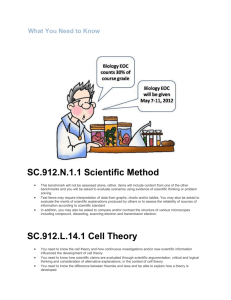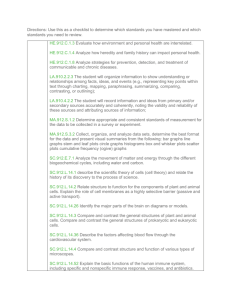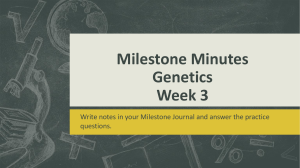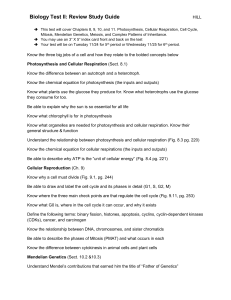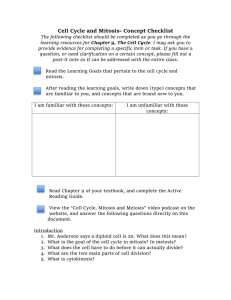Benchmarks
advertisement
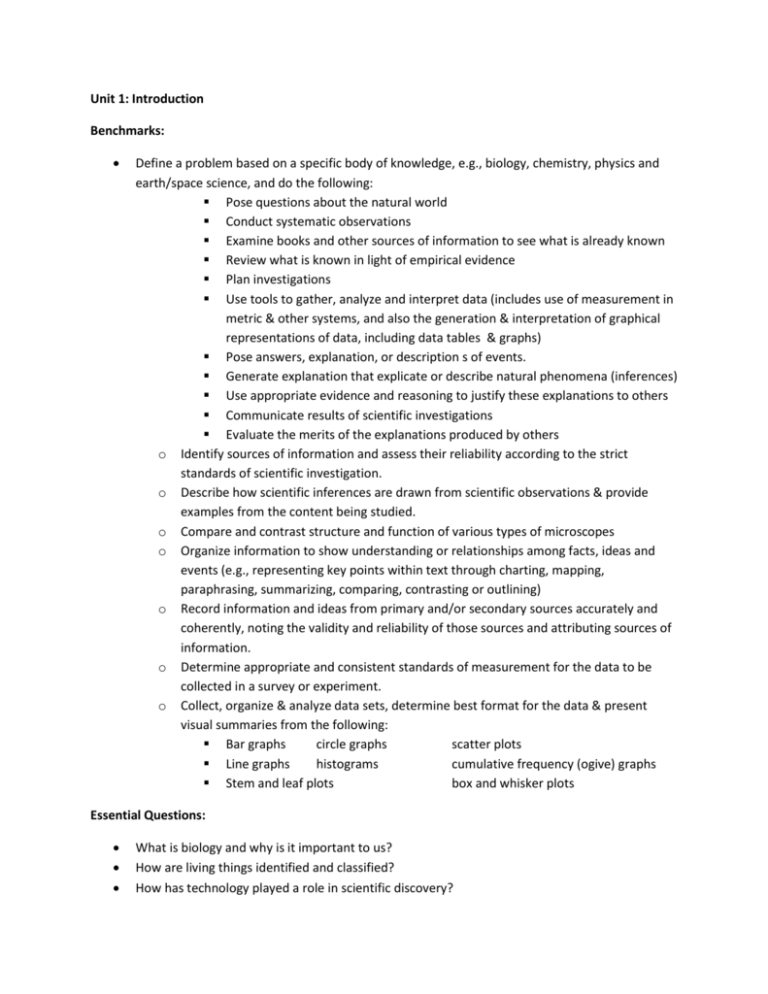
Unit 1: Introduction Benchmarks: Define a problem based on a specific body of knowledge, e.g., biology, chemistry, physics and earth/space science, and do the following: Pose questions about the natural world Conduct systematic observations Examine books and other sources of information to see what is already known Review what is known in light of empirical evidence Plan investigations Use tools to gather, analyze and interpret data (includes use of measurement in metric & other systems, and also the generation & interpretation of graphical representations of data, including data tables & graphs) Pose answers, explanation, or description s of events. Generate explanation that explicate or describe natural phenomena (inferences) Use appropriate evidence and reasoning to justify these explanations to others Communicate results of scientific investigations Evaluate the merits of the explanations produced by others o Identify sources of information and assess their reliability according to the strict standards of scientific investigation. o Describe how scientific inferences are drawn from scientific observations & provide examples from the content being studied. o Compare and contrast structure and function of various types of microscopes o Organize information to show understanding or relationships among facts, ideas and events (e.g., representing key points within text through charting, mapping, paraphrasing, summarizing, comparing, contrasting or outlining) o Record information and ideas from primary and/or secondary sources accurately and coherently, noting the validity and reliability of those sources and attributing sources of information. o Determine appropriate and consistent standards of measurement for the data to be collected in a survey or experiment. o Collect, organize & analyze data sets, determine best format for the data & present visual summaries from the following: Bar graphs circle graphs scatter plots Line graphs histograms cumulative frequency (ogive) graphs Stem and leaf plots box and whisker plots Essential Questions: What is biology and why is it important to us? How are living things identified and classified? How has technology played a role in scientific discovery? What careers are available in the field of Biology? What is scientific inquiry? How are independent and dependent variables identified on a graph? How do the functions of compound, dissecting, scanning electron and transmission electron microscopes differ? How does peer review/publishing affect scientific discovery? How do observations lead to scientific inferences? Why must guidelines be followed to perform an experiment in a safe manner? Unit 2: Biochemistry Benchmarks: Describe basic molecular structures & primary functions of the 4 major categories of biological macromolecules. o Explain the role of enzymes as catalysts that lower the activation energy of biochemical reactions. Identify factors, such as pH and temperature, and their effect on enzyme activity. Discuss the special properties of water that contribute to Earth’s suitability as an environment for life: cohesive behavior, ability to moderate temperature, expansion upon freezing and versatility as a solvent. Essential Questions: How do chemical principles affect living things? Why is water essential to life? Why are macromolecules necessary to sustain life? Why are properly functioning enzymes essential for all living things? What are the 3 subatomic particles and where are they found in the atom? What are ions and how are they important in biological processes? How do atoms bond to form molecules? How do the properties of water influence life on Earth? How does water dissolve substances? How do the properties of water make it able to sustain life? What types of molecules are in the body and how do their structures differ? How are macromolecules used in the cells? How does each of the four major categories of macromolecules support the body? How does molecular structure impact a molecule’s function? How does molecule structure impact chemical reactions? How do enzymes act as catalysts? How do various factors affect enzymes? What is the role of enzymes in the body? Unit 3: Cell Biology Benchmarks: Describe the scientific theory of cells (cell theory) & relate the history of its discovery to the process of science. o Recognize that the strength or usefulness of a scientific claim is evaluated through scientific argumentation, which depends on critical & logical thinking, and the active consideration of alternative scientific explanations to explain the data presented. o Identify what is science, what clearly is not science, and what superficially resembles science (but fails to meet the criteria for science). o Explain that a scientific theory is the culmination of many scientific investigations drawing together all the current evidence concerning a substantial range of phenomena; thus, a scientific theory represents the most powerful explanation scientists have to offer. o Recognize that theories do not become laws, nor do laws become theories; theories are well-supported explanations and laws are well-supported descriptions. Compare & contrast general structures of plant & animal cells. Compare & contrast general structures of prokaryotic & eukaryotic cells. o Relate structure to function for the components of plant and animal cells. Explain the role of cell membranes as a highly selective barrier (passive and active transport). Compare and contrast mitosis and meiosis and relate to the processes of sexual and asexual reproduction and their consequences for genetic variation. o Explain the relationship between mutation, cell cycle, and uncontrolled cell growth potentially resulting in cancer. o Describe the cell cycle, including the process of mitosis. Explain the role of mitosis in the formation of new cells and its importance in maintaining chromosome number during asexual reproduction. o Describe the process of meiosis, including independent assortment and crossing over. Explain how reduction division results in the formation of haploid gametes or spores. Explain the interrelated nature of photosynthesis and cellular respiration. o Identify the reactants, products and basic functions of photosynthesis. o Identify the reactants, products and basic functions of aerobic and anaerobic cellular respiration. o Connect the role of adenosine triphosphate (ATP) to energy transfers within a cell. Essential Questions: How did technology affect the development of cell theory? How are cell structures adapted to their functions? How do organisms obtain energy if energy cannot be created or destroyed? How does one cell produce new cells? What are the main points of the cell theory? What technology advanced cell theory? How is a scientific claim evaluated and verified? How do you tell whether something is science or pseudo-science? How is a theory developed How do you differentiate between a theory and a law? How do you differentiate between an animal cell and a plant cell? How do you differentiate between a prokaryotic and eukaryotic cell? How do cell structures support cell function? How does the cell membrane support cells in getting needed nutrients? How did eukaryotic cells evolve? How do the processes of photosynthesis and cellular respiration form a cycle? How does photosynthesis create the food that is used for energy in cellular respiration? What are the products and reactants of photosynthesis? What are the products and reactants of cellular respiration? What is the role of ATP in energy transfer? How are mitosis and meiosis similar but different? How does mitosis allow for asexual reproduction? Why is meiosis necessary for sexual reproduction and how does it allow for creating genetic diversity? How do the stages of mitosis produce identical copies of cells? How does mitosis for new cells that maintain the chromosomes number in the parent cells? How can cell mutations lead to cancer? How can independent assortment and crossing over occur during meiosis? How does meiosis result in the formation of haploid gametes (including spores)? How are binary fissions and mitotic cell division similar and different? Unit 4: Genetics Benchmarks: Use Mendel’s laws of segregation and independent assortment to analyze patterns of inheritance. o Discuss observed inheritance patterns caused by various modes of inheritance, including dominant, recessive, co-dominant, sex-linked, polygenic and multiple alleles. Describe the basic process of DNA replication and how it relates to the transmission and conservation of the genetic information. o Explain how mutations in the DNA sequence may or may not result in phenotypic change. Explain how mutations in gametes may result in phenotypic changes in offspring. o Explain the basic processes of transcription and translation, and how they result in the expression of genes. o Explain how and why the genetic code is universal and is common to almost all organisms. Compare and contrast mitosis and meiosis and relate to the processes of sexual and asexual reproduction and their consequences for genetic variation. o Explain the relationship between mutation, cell cycle and uncontrolled cell growth potentially resulting in cancer. o Describe the cell cycle, including the process of mitosis. Explain the role of mitosis in the formation of new cells and its importance in maintaining chromosome number during asexual reproduction. o Describe the process of meiosis, including independent assortment and crossing over. Explain how reduction division results in the formation of haploid gametes or spores. Essential Questions: How are traits passed from parents to offspring? How does DNA play a role in genetic inheritance? How can the study of genetics improve human health? How and why do scientists manipulate DNA in living cells? How can independent assortment and crossing over occur during meiosis? Why is meiosis necessary for sexual reproduction and how does it allow for genetic diversity? How do the laws of segregation and independent assortment affect the analysis of inheritance patterns? How does the mode of inheritance (dominance, co-dominance, etc.) affect the prediction and analysis of inheritance patterns? How does the process of DNA replication enable genetic information to be transmitted and used to build proteins? How do the processes of transcription and translation determine how genes are expressed? How is DNA alike in all organisms? How can DNA mutate? Why don’t all mutations result in visible change? Why do scientists use DNA as evidence that all organisms are related? How can biotechnology have positive and negative impacts on society? Unit 5: Evolution Benchmarks: Explain how the scientific theory of evolution is supported by the fossil record, comparative anatomy, comparative embryology, biogeography, molecular biology and observed evolutionary change. o Recognize that the strength or usefulness of a scientific claim is evaluated through scientific argumentation, which depends on critical & logical thinking, and the active consideration of alternative scientific explanations to explain the data presented. o Identify sources of information and assess their reliability according to the strict standards of scientific investigation. o Describe how scientific inferences are drawn from scientific observations & provide examples from the content being studied. o Identify what is science, what clearly is not science, and what superficially resembles science *but fails to meet the criteria for science). o Explain a scientific theory is the culmination of many scientific investigations drawing together all the current evidence concerning a substantial range of phenomena; thus, a scientific theory represent the most powerful explanation scientists have to offer. o Recognize that theories do not become laws, nor do laws become theories; theories are well-supported explanations and laws are well-supported descriptions. o Identify basic trends in hominid evolution from early ancestry six million years ago to modern humans, including brain size, jaw size, language and manufacture of tools. Describe the scientific explanations of the origin of life on Earth. o Recognize that the strength or usefulness of a scientific claim is evaluated through scientific argumentation, which depends on critical and logical thinking, & the active consideration of alternative scientific explanations to explain the data presented. o Identify sources of information and assess their reliability according to the strict standards of scientific investigation. o Identify what is science, what clearly is not science, and what superficially resembles science (but fails to meet the criteria for science). Describe the conditions required for natural selection, including: overproduction of offspring, inherited variation, and the struggle to survive, which result in differential reproductive success. o Recognize that the strength or usefulness of a scientific claim is evaluated through scientific argumentation, which depends on critical and logical thinking, and the active consideration of alternative scientific explanations to explain the data presented. o Discuss mechanisms of evolutionary change other than natural selection such as genetic drift and gene flow. o Describe how mutation and genetic recombination increase genetic variation. Essential Questions: How are the mechanisms of evolutionary change supported by evidence (e.g. fossil records, DNA, comparative anatomy, genetic drift, gene flow, etc.)? How have living things changed over time? How do you use an organism’s characteristics to classify it in a particular domain or kingdom? How and why organisms are hierarchically classified based on evolutionary relationships? Why have ways of classifying organisms changed over time? How are scientific claims evaluated? How do observations lead to scientific inferences in Biology? How does biological diversity increase with the origin of new species and decrease by extinction? How is the brain divided into parts and where are those parts located? How do factors such as genetics, nutrition and behavior affect blood flow through the cardiovascular system? How does the immune system protect humans from disease? How does the human immune system respond to vaccines and antibiotics? How is the health of individuals and the public affected by genetic factors, environmental factors and pathogenic agents? What are the important structures in the female and male reproductive systems and how do they work together to create a zygote? How does a human develop from a zygote to a “full term” baby? Unit 6: Diversity of Organisms Benchmarks: Identify the major parts of the brain on diagrams or models. Describe the factors affecting blood flow through the cardiovascular system. Explain the basic functions of the human immune system, including specific & nonspecific immune response, vaccines and antibiotics. o Explain significance of genetic factors and environmental factors, and pathogenic agents to health from perspectives of both individual & public health o Evaluate the impact of biotechnology on the individual, society and the environment, including medical and ethical issues. o Analyze how heredity and family history can impact personal health. o Analyze strategies from prevention, detection and treatment of communicable and chronic diseases. Discuss distinguishing characteristics of the domains and kingdoms of living organisms. o Recognize that the strength or usefulness of a scientific claim is evaluated through scientific argumentation, which depends on critical & logical thinking, and the active consideration of alternative scientific explanations to explain the data presented. o Describe how scientific inferences are drawn from scientific observations & provide examples from the content being studied. o Describe how and why organisms are hierarchically classified and based on evolutionary relationships. o Explain the reasons for changes in how organisms are classified. Describe the basic anatomy and physiology of the human reproductive system. Describe the process of human development from fertilization to birth and major changes that occur in each trimester of pregnancy. Essential Questions: Why is there a strong relationship between how living things evolved and how they are classified? How do the systems of the body work independently and collectively to maintain homeostasis? Unit 7: Ecology Benchmarks: Relate the structure of each of the major plant organs and tissues to physiological processes. Analyze how population size is determined by births, deaths, immigration, emigration and limiting factors (biotic and abiotic) that determine carrying capacity. o Identify sources of information and assess their reliability according to the strict standards of scientific investigation. o Explain the general distribution of life in aquatic systems as a function of chemistry, geography, light, depth salinity and temperature. o Describe changes in ecosystems resulting from seasonal variations, climate change and succession. o Recognize the consequences of the losses of biodiversity due to catastrophic events, climate changes, human activity and the introduction of invasive, non-native species. Use a food web to identify and distinguish producers, consumers and decomposers. Explain the pathway of energy transfer through trophic levels and the reduction of available energy at successive trophic levels. o Analyze the movement of matter and energy through the different biogeochemical cycles, including water and carbon. Predict the impact of individuals on environmental systems & examine how human lifestyles affect sustainability. o Recognize that the strength or usefulness of scientific claim is evaluated through scientific argumentation, which depends on critical and logical thinking, and the active consideration of alternative scientific explanations to explain the data presented. o Evaluate costs & benefits of renewable & nonrenewable resources, such as water, energy, fossil fuels, wildlife and forests. o Discuss the need for adequate monitoring of environmental parameters when making policy decisions. o Evaluate how environment and personal health are interrelated. Explain the interrelated nature of photosynthesis and cellular respiration. o Identify the reactants, products and basic functions of photosynthesis. o Identify the reactants, products and basic functions of aerobic and anaerobic cellular respiration. o Connect the role of adenosine triphosphate (ATP) to energy transfers within a cell. Essential Questions: Why are plants so important to survival? How do matter and energy move through an ecosystem? How do living and nonliving parts of the Earth interact and affect the survival of organisms? How do environmental factors (biotic and abiotic) affect population size? How have human activities shaped local and global ecology? How are the structures of plant tissues and organs directly related to their roles in physiological processes? How does matter move through different biogeochemical cycles (such as carbon through the carbon cycle)? How can energy be transformed from one form to another? How do organisms cooperate and compete in ecosystems? How does energy move through a food web or energy pyramid? How can ecosystems be changed by seasonal variations, climate changes and succession? What affects carrying capacity and how can it affect population size of an ecosystem? How does the chemistry, geography, light, depth, salinity, and/or temperature of an aquatic system affect what organisms can live there? How can reducing biodiversity positively or negatively impact ecosystems and humans? How do you assess the reliability of sources of information according to scientific method? How can the actions of humans impact environmental systems and/or affect sustainability? How can the environmental impacts of using renewable and nonrenewable resources differ? How can scientific claims be evaluated?
